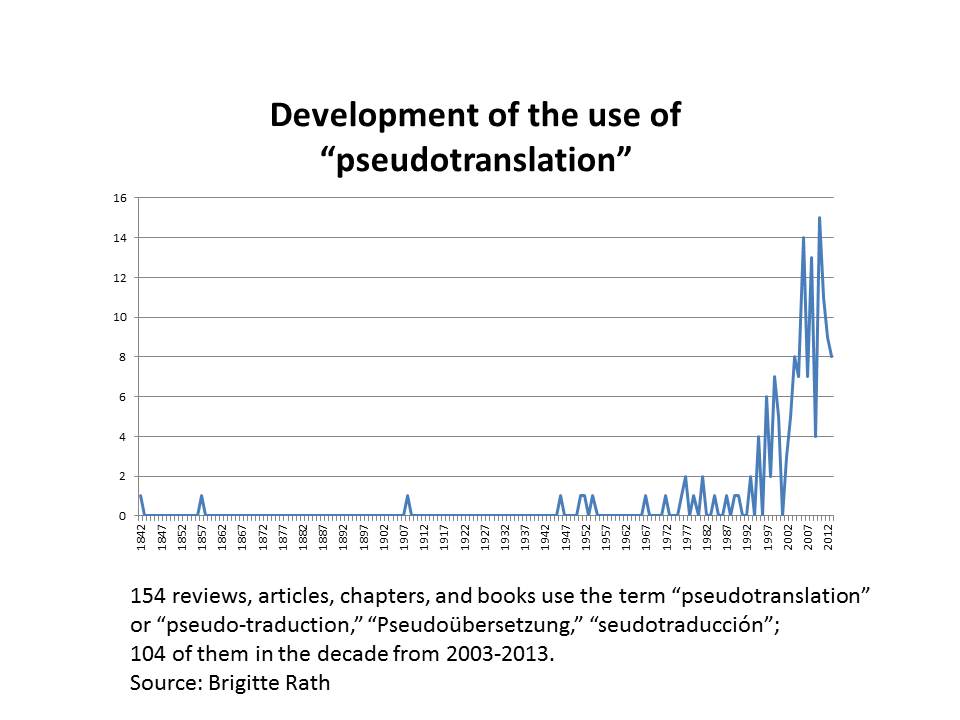Main Content
In 1721, Montesquieu published, anonymously, his Persian Letters. In the preface, he claimed that two Persians had lodged with him, and that he had translated into French the letters they wrote to and received from Persia. The dates of the letters retain Persian names for the months, and the “translator” provides some footnotes with explanations on Persian customs. The text invites readers to imagine a preceding, original, authentic text in Persian, and to picture the first audience for these letters, one that would not need the additional information provided in the footnotes, because they would belong to what was, for French readers, a markedly unknown culture. Even as it marks the foreign as opaque, Montesquieu’s text makes it readable; it plays with the readers’ voyeuristic desire to gain access to the inaccessible: private letters written in a foreign language, and an alien perspective on the readers’ familiar world.
The translation studies scholar Gideon Toury defines pseudotranslations as “texts which have been presented as translations with no corresponding source texts in other languages ever having existed” (40). In Toury’s view, pseudotranslation is a property of texts; because there was no Persian original, the Persian Letters are a pseudotranslation, whether the reader is aware of this or not. Beyond this text-centered model, I propose thinking of pseudotranslation as a mode of reading that oscillates between seeing the text as an original and as a translation pointing towards an imagined original, produced in a different language and culture for a different audience.
The idea of pseudotranslation sharpens some central concepts of Comparative Literature. “World Literature,” according to David Damrosch, is “always as much about the host culture’s values and needs as it is about a work’s source culture” (283). Foregrounding a text’s imaginary origin in a different culture reads this “double refraction” as already built into a text. It thus stresses the conjecture and transnational imagination that is always involved in reading a text as world literature. Pseudotranslation as a mode of reading has also much to contribute to questions of translatability, representation, voice, authorship, authenticity, and multilingualism.
Pseudotranslation opens up a new approach to literary texts spanning languages and periods, among them Cervantes’ Don Quixote (1605/15), MacPherson’s Ossian (1761), Markoe’s Algerine Spy in Pennsylvania (1787), Mérimée’s Guzla (1827), Holz/Schlaf’s Papa Hamlet (1889), Raja Rao’s Kanthapura (1938), Lem’s Głos Pana [His Master’s Voice] (1968), Makine’s Fille d’un héros de l’Union soviétique (1990), or Bitov’s Преподаватель симметрии [The Symmetry Teacher] (2008). This apparent ubiquity of original texts that invite their audience to read them as if they were translations merits more attention. It further strengthens, for instance, arguments for a transnational history of literature and genres since, as Aravamudan, Ballaster and Lombaz (among others) have shown, pseudotranslation shapes the development of the novel and the prose poem.[1]
Pseudotranslation is an idea of the (past) decade. Of the 154 sources that use the term “pseudotranslation,” roughly 2/3 were published in the last decade, and more deal with the same phenomenon under different names, such as “fictitious translation,” “assumed translation,” “supposed translation,” or “original translation.”

The overabundance of terms coincides with a scarcity of cross-references between the individual contributions which often show little awareness for the developing field. This seems about to change: two recent conferences focused exclusively on pseudotranslation, some articles frame their case studies more broadly, and the first edited volumes and books dedicated to the topic have appeared; the new field has reached a tipping point.[2] It may allow us to explore the allure and danger of imagining transparent opacity.
Endnotes
[1] See also McMurran, Monte, Vincent-Munnia, and Marmarelli.
[2] See, for example, Apter, Martens, Santoyo, Martens and Vanacker, Beebee, and Jenn.
Works Cited
Apter, Emily. “Translation with No Original: Scandals of Textual Reproduction.” Nation, language, and the ethics of translation. Ed. Sandra Bermann and Michael Wood. Princeton: Princeton UP, 2005. 159–74
Aravamudan, Srinivas. “Fiction/Translation/Transnation: The Secret History of the Eighteenth-Century Novel.” Paula Backscheider and Catherine Ingrassia, eds. A companion to the eighteenth-century English novel and culture. Chichester: Wiley-Blackwell, 2005.
Aravamudan, Srinivas. Enlightenment Orientalism. Resisting the Rise of the Novel. Chicago: U of Chicago P, 2012.
Ballaster, Ros. “Narrative Transmigrations: The Oriental Tale and the Novel in Eighteenth-Century Britain.” Paula Backscheider and Catherine Ingrassia, eds. A companion to the eighteenth-century English novel and culture. Chichester: Wiley-Blackwell, 2005.
Beebee, Thomas O. Transmesis. Inside translation’s black box. New York: Palgrave Macmillan, 2012.
Damrosch, David. What is world literature? Princeton: Princeton UP, 2003.
Jenn, Ronald. La pseudo-traduction, de Cervantès à Mark Twain. Leuven: Peeters, 2013.
Lombez, Christine. “La ‘traduction supposée’ ou: de la place des pseudotraductions poétiques en France.” Fictionalising translation and multilingualism. Ed. Dirk Delabastita and Rainier Grutman. Antwerpen: Hogeschool Antwerpen Hoger Inst. voor Vertalers en Tolken, 2005. 107–21.
Marmarelli, Trina. “Other Voices: Strategies of Spatial, Temporal, and Psychological Distancing in the Early French Prose Poem.” Pacific Coast Philology 40.1 (2005): 57–76
Martens, David. “De la mystification à la fiction: la poétique suicidaire de la fausse traduction.” Translatio in fabula. Enjeux d'une rencontre entre fictions et traductions. Ed. Sophie Klimis. Bruxelles: Facultés universitaires Saint-Louis, 2010. 63–81.
Martens, David and Beatrijs Vanacker, eds. Scénographies de la pseudo-traduction. Spec. issue of Les lettres romanes 67.3-4 (2013).
McMurran, Mary Helen. The spread of novels. Translation and prose fiction in the eighteenth century. Princeton: Princeton UP, 2010.
Monte, Steven. Invisible fences. Prose poetry as a genre in French and American literature. Lincoln: U of Nebraska P, 2000.
Santoyo, Julio-César. “Seudotraducciones: Pre-textos & pretextos de la falsificación.” Mundus vult decipi. Estudios interdisciplinares sobre falsificación textual y literaria. Ed. Javier Martínez García. Madrid: Ediciones Clásicas, 2012. 355–66.
Toury, Gideon. Descriptive translation studies and beyond. Amsterdam: John Benjamins, 1995.
Vincent-Munnia, Nathalie, S. Bernard-Griffiths, and Robert Pickering, eds. Aux origines du poème en prose français (1750-1850). Paris: Champion, 2003.
